 My mother once remarked that she’s amazed at the useful tidbits of information that I find online. I was surprised by her observation. I’m not particularly adept at search terms. Nor am I truly computer savvy. I manage. But when I thought about it, I realized we were both right.
My mother once remarked that she’s amazed at the useful tidbits of information that I find online. I was surprised by her observation. I’m not particularly adept at search terms. Nor am I truly computer savvy. I manage. But when I thought about it, I realized we were both right.
While skill has little to do with my online efforts, serendipity has played a large part in leading me to water in the online world.
When I finished my novel Troll-magic, I discovered Dean Wesley Smith’s blog with all his marvelous information for the writer who wants to get her work out to readers.
When I was longing for a greener way to wrap gifts, I stumbled upon a video that showed how to wrap presents using cloth.
When I realized that our modern ideas about what comprises healthy eating were probably incorrect, I bumped into Sally Fallon’s book, Nourishing Traditions.
There were more happy discoveries, but I’m not going to list them all now. 😀
So what’s my latest discovery?
The KonMari technique for tidying up.
I’ve always had a liking for books about organizing and de-cluttering. The first one I ever encountered remains one of my favorites: Clutter’s Last Stand by Don Aslett. It made me laugh out loud even while it inspired me. Organizing From the Inside Out by Julie Morgenstern was another good one. And Clear Your Clutter with Feng Shui also had some good points, although I disagreed profoundly with some of the information presented.
With my penchant for books on de-cluttering, you might think I struggled with tidying and organizing, but for much of my adult life I didn’t. My home felt comfortable to me and not overburdened with things. I read the books for enjoyment and for inspiration when I embarked on one of my periodic pruning of the possessions.
But after my husband and I bought a house, the balance tipped. Our house had less storage than my previous living spaces. My parents asked me to take the boxes I’d been storing in their house. (They were generous to keep them for as long as they did.) And my book collection reached a size that overflowed our bookshelves.
Then we had kids. Then I experienced a long string of illnesses interspersed with injuries, during which housekeeping fell even further behind. And, and, and.
Twenty years down the pike, my home was cluttered, and even my own spaces within it were cluttered. Cluttered enough that I felt overwhelmed and stuck. I didn’t know where to start.
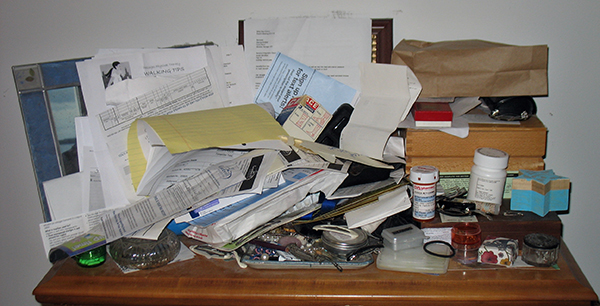
That was the unhappy state of Casa Ney-Grimm when I saw mention of Marie Kondo’s book, The Life-Changing Magic of Tidying Up, on the monthly newsletter from LibraryThing. The title attracted me, and I poked around on the internet to learn more about it. I discovered oodles of videos while I waited for my turn at the copy in our local library. What I found inspired me.
I’d looked at a few new books on de-cluttering when I noticed how stuck I felt around the whole issue, but they seemed to merely re-hash all the stuff I already knew. I needed a fresh, new angle of approach to deal with my situation. Neither plain commonsense nor the old advice from experts was enough. Marie Kondo’s technique looked to be that new angle I needed. I decided to give it a try.
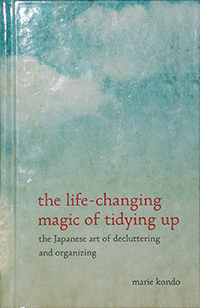 What is Marie Kondo’s technique?
What is Marie Kondo’s technique?
1 • Tidy by category, not by location
2 • Keep only those items which spark joy
I liked the first of those two instructions, because it was different from anything I’d heard before. And I needed something different. I’d always tidied and organized room by room. The bedroom. The living room. The kitchen. And so on. What might organizing by category be like? What categories would Kondo use?
The second instruction reminded me of the quote by William Morris: “Have nothing in your house that you do not know to be useful, or believe to be beautiful.” I wasn’t convinced it would be helpful, but I was wrong. After I’d heard Marie Kondo speak (via a translator, since she is Japanese) and after I’d read her book, I realized that there was one detail that was critical to my success with instruction #2.
Hold each item in my hands and notice how my body feels.
If my body feels energized and light, the item “sparks joy” in Kondo’s vocabulary. That item is a keeper.
If my body has that slight (or not so slight) sinking sensation, then the item does not “spark joy.” It needs to go elsewhere.
The first instruction – tidying by category – also possessed more to it than I’d initially realized. Kondo not only recommends tidying by category, but tackling the categories in a specific order, from easiest to hardest. That way, you train your ability to discern which items “spark joy” and which do not.
What is her order?
1 • Clothing
2 • Books
3 • Papers
4 • Miscellany
5 • Memorabilia
With that information, I dove into my clothing. It was time to stop thinking and pondering, time to start doing.
Kondo recommends finding absolutely everything in your house in each category, placing it on the floor of one room (or on your bed), and going through it in one fell swoop.
I can see why she does. Most people say: “Wow! I didn’t realize quite how many clothes I owned!” Plus comparing how each of two dozen tops makes your body feel makes it really obvious which ones “spark joy” and which do not.
But I’ll confess that I didn’t follow her instructions to the letter. I started with the clothes in my wardrobe and my chest of drawers. I didn’t pull out the dresses stashed in the back corner of my daughter’s closet. I didn’t pull out the trunk of clothes buried in the eaves under the roof. I knew that if I wanted to get started NOW – and I did – I needed to go with what could be accessed easily.
So I went through my clothes, and it was easy.
I discovered two consistent mistakes that I’d made all the other times I’d de-cluttered in my life. It hadn’t mattered when I was younger and didn’t have as much stuff. But it was a heavy contributor to the clutter that built up later.
I’d tended to get confused about useful things. Using the “spark joy” criterion cut through my confusion and showed me what was really useful and what was not. In the past, I been keeping at least a few things that might be useful, but were not truly so, because I never did actually use them.
I’d also kept things that were beautiful, but that I didn’t love. I’d never realized that just because I found something beautiful didn’t mean I loved it. I’d always assumed the two things went together. For me, they do not.
Getting rid of three gigantic leaf bags of clothing that didn’t “spark joy” felt wonderful. Of course, I’d felt that particular relief before, but this time there was something else that I’d never felt before. Kondo had mentioned it in her book, but I’d not truly realized what it would be like.
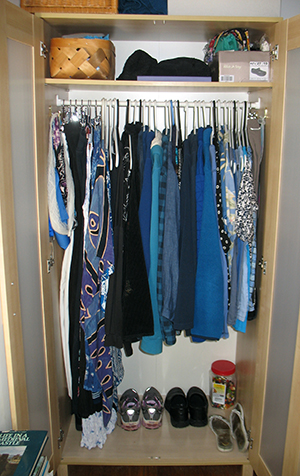 When I open my wardrobe now, I see only clothing that I love.
When I open my wardrobe now, I see only clothing that I love.
I’d never had that experience before. Never.
Always, until this month, my closet included a few (or more than a few) garments that I didn’t love. Opening the wardrobe doors onto only clothes that I love feels really different. It’s energizing. I begin to see why Kondo says her method is life-changing. Imagine if my whole house – not just my wardrobe – produced this feeling! I hope to find out!
I also discovered that I really did have enough clothes, even when I kept only those I loved.
I’d wondered about that, and apparently I’m not alone. Many of Kondo’s clients have wondered the same. What I learned is that the reason I’d felt like I didn’t have enough clothes before I got rid of so many was that the clothes I loved were hidden by all the clothes I’d grown to hate. It’s a paradox. Now, with fewer clothes, that “not enough” feeling is gone. I have enough.
Imagine that feeling multiplied through the whole house!
Kondo also recommends folding clothes into neat rectangles that can be placed in a drawer the way a book is placed in a bookshelf. This allows you to see everything in the drawer at a glance. It allows more items to fit in the drawer. And it prevents items at the bottom of stacks from getting crushed and creased, because there are no stacks. (The photo at the top of this post shows one of my drawers with the clothes folded and placed in this way.)
I was so energized with my experience of KonMari-ing my clothes, that I wanted to go on.
The next category should have been books. But I hated looking at the messy top of my chest of drawers, when the interior was so wonderful. And most of the clutter was paper generated by doctors’ offices during my last two illnesses. I didn’t want to wait until I’d finished books and started on papers. I decided to do a little location-based de-cluttering and tackled both the nightstand by my bed and the top of the chest.
I put the papers in a pile on my coffee table in the living room and went through them all in one swoop. Most could be discarded – either recycled or shredded. I placed them in the appropriate bins. A few went into a medical file folder.
I placed all the items on my bed and then sorted them – holding each in my hands – into keep or toss (give away). Here is where my discernment of the difference between “might be useful” and “actually useful,” as well as the difference between “beautiful” and “loved,” made a huge difference. I tossed many useful and beautiful things and felt great about it, because I kept the things I really use and love.
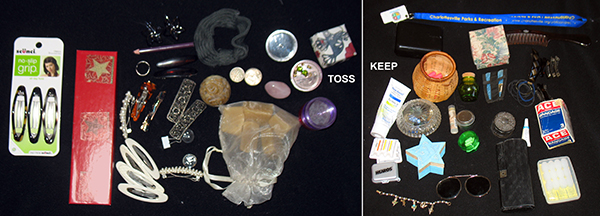
I changed my mind about the fabric-covered box that I’d thought to keep. It was actually useful (to store my barrettes), but I didn’t love it. In fact, just looking at it produces that sinking feeling, so it definitely needs to go. I chose an old blue and white sugar bowl from the china closet to keep my barrettes instead.
I aimed for quick in my first stab at the KonMari technique, rather than perfect. I suspect I will need to fine-tune some of the work I’ve done. I know I’ll realize that some of the items I’ve kept really don’t “spark joy.” That’s okay. Kondo herself recommends doing it right and doing it once. But I’m comfortable with revisiting my work after I’ve done it. I don’t fear the dreaded “rebound.” Maybe because that doesn’t feel like my problem.
My problem has been getting out from under. And doing this quickly will get me out from under. Once I’m out from under, I won’t feel overwhelmed. I’ll be up for tackling a little fine-tuning and the correcting of any mistakes.
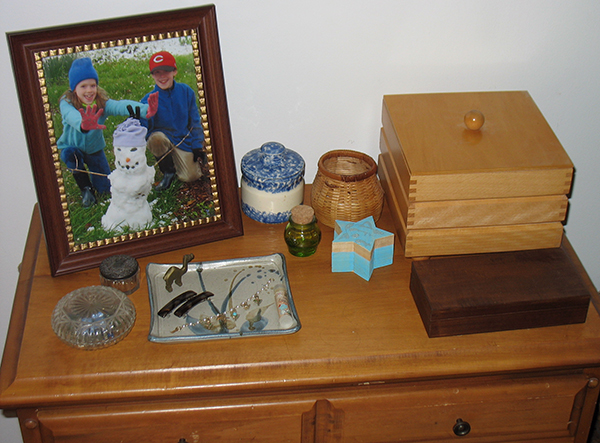
My spot de-cluttering has worked so well, that I’m going to do a bit more. There’s a shelving unit in the living room that really belongs in the study. It’s slowly accumulated clutter while awaiting its transfer to the proper room. I’m going to de-clutter it next. It will surely need that before it can be moved anyway!
And then I’ll move on to books!
I plan to share how each of the different categories goes for me. Cheer me on! 😀
For more life-changers, see:
Writer’s Journey
Test First, Then Conclude!
Butter and Cream and Coconut, Oh My!
Great Soap & Etcetera Quest

Those before/after pics are telling! … well done. 😀
Thank you! I should have taken more before pics, but I kept diving in and forgetting all about it. Still, the wardrobe and the bureau drawers were just as bad as the bureau top. Promise!
Thank you for detailing your process here.
The first step, though, stops me dead in my tracks: put all your belongings in category X in one place.
I can’t do that without an assistant. Not enough physical energy to even do one closet – I can’t stand, I can’t carry. And sorting takes an enormous amount of psychic energy if you are going to discard things. The joy part sounds useful – but again, energy for decisions is scarce, and you’re making a lot of decisions.
When I do find that cleaner and assistant, this is a post I will re-read.
And I love Don Aslett, too – I think I have a whole bunch of his books. Back when I was not disabled, he was my guru. I still have the white towel tubular cleaning cloths I made with his instructions – and use them daily, some thirty years later. THAT’s useful.
As I mentioned above, I cheated on that one. I do see its purpose, but I would never have started if I’d waited until I had the fortitude to pull out the clothes squirreled away in the eaves and the back of my daughter’s closet.
I’ve found that one often benefits from customizing someone else’s solution to one’s own unique circumstances. They aren’t you. Simple as that. Take the parts that work and leave the rest.
I plan to cheat when I get to the books. Marie Kondo instructs one to place all one’s books in piles on one’s floor. And then go through them.
No. Just no. That might work when you have 100 books. Or even 200 books. Or when you are young enough that all that bending doesn’t make your back go out. When you have 8 bookcases full plus 4 boxes in the basement and 8 boxes in the eaves… It would take all day to get them all out. And then you’d have to go to a hotel for the night, because it wouldn’t be possible to move through the house getting dinner or to brush your teeth before bed.
What I will do is take each book off the shelf to hold it, see how I feel, and then either put it back on the shelf or put it in the giveaway box. And those books currently tucked in boxes will simply have to wait until later.
My main takeaways were: use category ahead of location when going through it all; use how my body feels when I hold an item to gain more thorough insight more quickly.
I’ve already given most of my books to the library for their sales. I sent a big box (2?) of my writing books to my beta reader, a young writer. What she does with them is no longer my problem!
There are still a few, but they are getting less and less useful.
Clothes? Mine aren’t the problem, though I can reduce my small accumulation to an even smaller set, which I will do – I’m only taking one dresser-full and one closetful to the CCRC when the time comes.
It’s everyone else’s junk! (That’s probably not quite the truth, but it will do for now.)
😀
I’m finding that reducing my own junk brings a lot of satisfaction, even in the face of living with other people’s junk.
You are ahead of me with the book pruning. My last book pruning occurred before kindle. Should be interesting!
Actually, you’ve given me hope: I wasn’t sure how I was going to use the assistant to get this house dejunked – and your technique is perfect for using with an assistant.
Excellent! I’m glad!
That drawer is inspirational. I’ll be doing more KonMari this summer. In the meantime, when I get a call from American Veterans for a donation bag, I use the spark-joy test to fill a bag or two.
Smart! I’ll add that to my own arsenal. 😀
I’m loving the KonMari set-up for drawers. It works really well for me, making the whole cycle of clothing usage – dressing, laundry, putting away again – much easier and more pleasant.